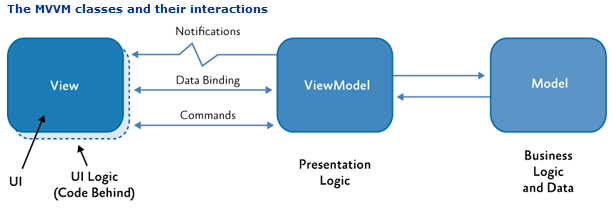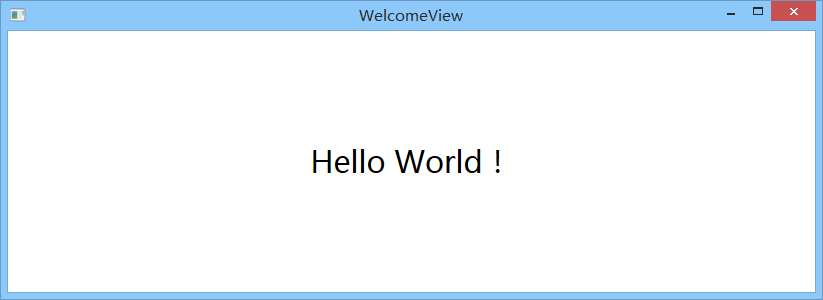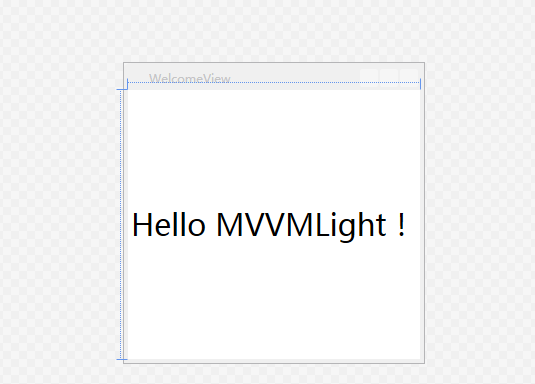本篇内容介绍了“MVVMLight项目Model View结构怎么写”的有关知识,在实际案例的操作过程中,不少人都会遇到这样的困境,接下来就让小编带领大家学习一下如何处理这些情况吧!希望大家仔细阅读,能够学有所成!一、先来说说分层
本篇内容介绍了“MVVMLight项目Model View结构怎么写”的有关知识,在实际案例的操作过程中,不少人都会遇到这样的困境,接下来就让小编带领大家学习一下如何处理这些情况吧!希望大家仔细阅读,能够学有所成!

如图:
View负责前端展示,与ViewModel进行数据和命令的交互。
ViewModel,负责前端视图业务级别的逻辑结构组织,并将其反馈给前端。
Model,主要负责数据实体的结构处理,与ViewModel进行交互。
根据上述的分层,我们来进行编码。
先建立一个完整三层结构的目录,如图,包含Model、View、ViewModel三层文件夹:

using GalaSoft.MvvmLight; using System; using System.Collections.Generic; using System.Linq; using System.Text; using System.Threading.Tasks; namespace MVVMLightDemo.Model { public class WelcomeModel : ObservableObject { private String introduction; /// <summary> /// 欢迎词 /// </summary> public String Introduction { get { return introduction; } set { introduction = value; RaisePropertyChanged(()=>Introduction); } } }很简单,仅仅是包含一个实体对象,这边注意的的是那他继承了一个父类:ObservableObject,这个父类的作用就是保证能够检测属性是否被改变。
它实现了INotifyPropertyChanged接口,通过触发PropertyChanged事件达到通知UI更改的目的;
所以我们在定义实体对象的时候,只需要调用RaisePropertyChanged(PropertyName)就可以进行属性更改通知了。
所以实体里面定义的每个属性都加上RaisePropertyChanged(PropertyName)的调用,就可以实现对UI的交互更新了。
using GalaSoft.MvvmLight;using MVVMLightDemo.Model;using System;using System.Collections.Generic;using System.Linq;using System.Text;using System.Threading.Tasks;namespace MVVMLightDemo.ViewModel{ public class WelcomeViewModel:ViewModelBase { /// <summary> /// 构造函数 /// </summary> public WelcomeViewModel() { Welcome = new WelcomeModel() { Introduction = "Hello World!" }; } #region 属性 private WelcomeModel welcome; /// <summary> /// 欢迎词属性 /// </summary> public WelcomeModel Welcome { get { return welcome; } set { welcome = value; RaisePropertyChanged(()=>Welcome); } } #endregion }}也很简单,包含了一个命名为Welcome的WelcomeModel属性,继承了ViewBaseModel父类,
ViewBaseModel同时继承 ObservableObject类和ICleanup接口。所以他同样有INotifyPropertyChanged接口的能力,
能够通过触发PropertyChanged事件达到通知View的目的;
构造函数中对 Welcome 属性进行了实例化。
<Window x:Class="MVVMLightDemo.View.WelcomeView" xmlns="Http://schemas.microsoft.com/winfx/2006/xaml/presentation" xmlns:x="http://schemas.microsoft.com/winfx/2006/xaml" Title="WelcomeView" Height="300" Width="300"> <Grid> <StackPanel VerticalAlignment="Center" HorizontalAlignment="Center" > <TextBlock Text="{Binding Welcome.Introduction}" FontSize="30" ></TextBlock> </StackPanel> </Grid> </Window>TextBlock 绑定了 Welcome.Introduction,所以应该显示Welcome对象下的Introduction属性。
这时候的ViewModel和View是没有任何关系的,所以我们在code-Behind的构造函数中写上如下代码:
using MVVMLightDemo.ViewModel;using System.windows; namespace MVVMLightDemo.View { /// <summary> /// Interaction logic for WelcomeView.xaml /// </summary> public partial class WelcomeView : Window { public WelcomeView() { InitializeComponent(); this.DataContext = new WelcomeViewModel(); } }把 WelcomeViewModel 赋值给当前视图的数据上下文。所以可以在当前视图中使用ViewModel中所有的公开属性和命令。
执行效果如下:

如果使用NuGet安装的是完整的一个是MVVM Light 框架,而非 MVVM Light libraries only的时候,总是会带上ViewModelLocator类,并且生成资源字典并加入到了全局资源中。

<Application x:Class="MVVMLightDemo.App" xmlns="http://schemas.microsoft.com/winfx/2006/xaml/presentation" xmlns:x="http://schemas.microsoft.com/winfx/2006/xaml" StartupUri="View/WelcomeView.xaml" xmlns:d="http://schemas.microsoft.com/expression/blend/2008" d1p1:Ignorable="d" xmlns:d1p1="http://schemas.openxmlfORMats.org/markup-compatibility/2006" xmlns:vm="clr-namespace:MVVMLightDemo.ViewModel" > <Application.Resources> <ResourceDictionary> <vm:ViewModelLocator x:Key="Locator" d:IsDataSource="True" /> </ResourceDictionary> </Application.Resources> </Application>所以每次App初始化的时候,就会去初始化ViewModelLocator类。
实际上他就是一个很基本的视图模型注入器。在构造器中把使用到的ViewModel统一注册,并生成单一实例。
然后使用属性把它暴露出来,每当我们访问属性的时候,就会返回相应的ViewModel实例。
using GalaSoft.MvvmLight; using GalaSoft.MvvmLight.ioc; using Microsoft.Practices.ServiceLocation; namespace MVVMLightDemo.ViewModel { /// <summary> /// This class contains static references to all the view models in the /// application and provides an entry point for the bindings. /// </summary> public class ViewModelLocator { /// <summary> /// Initializes a new instance of the ViewModelLocator class. /// </summary> public ViewModelLocator() { ServiceLocator.SetLocatorProvider(() => SimpleIoc.Default); #region Code Example ////if (ViewModelBase.IsInDesignModeStatic) ////{ //// // Create design time view services and models //// SimpleIoc.Default.ReGISter<IDataService, DesignDataService>(); ////} ////else ////{ //// // Create run time view services and models //// SimpleIoc.Default.Register<IDataService, DataService>(); ////} #endregion SimpleIoc.Default.Register<MainViewModel>(); } #region 实例化 public MainViewModel Main { get { return ServiceLocator.Current.GetInstance<MainViewModel>(); } } #endregion public static void Cleanup() { // TODO Clear the ViewModels } }注意的是,这边把MVVMLight 自带的SimpleIoc作为默认的服务提供者,它是个简易的注入框架。
为了统一化,并且在设计的时候可以看到看到ViewModel的数据,这边用ServiceLocator 又将SimpleIoc包裹了一层。
上面我们写了一个Hello World,这时候就可以用这种方式改装了。
using GalaSoft.MvvmLight; using GalaSoft.MvvmLight.Ioc; using Microsoft.Practices.ServiceLocation; namespace MVVMLightDemo.ViewModel { /// <summary> /// This class contains static references to all the view models in the /// application and provides an entry point for the bindings. /// </summary> public class ViewModelLocator { /// <summary> /// Initializes a new instance of the ViewModelLocator class. /// </summary> public ViewModelLocator() { ServiceLocator.SetLocatorProvider(() => SimpleIoc.Default); #region Code Example ////if (ViewModelBase.IsInDesignModeStatic) ////{ //// // Create design time view services and models //// SimpleIoc.Default.Register<IDataService, DesignDataService>(); ////} ////else ////{ //// // Create run time view services and models //// SimpleIoc.Default.Register<IDataService, DataService>(); ////} #endregion SimpleIoc.Default.Register<MainViewModel>(); SimpleIoc.Default.Register<WelcomeViewModel>(); } #region 实例化 public MainViewModel Main { get { return ServiceLocator.Current.GetInstance<MainViewModel>(); } } public WelcomeViewModel Welcome { get { return ServiceLocator.Current.GetInstance<WelcomeViewModel>(); } } #endregion public static void Cleanup() { // TODO Clear the ViewModels } }注册完WelcomeViewModel实例之后,我们就可以在相应的View中使用了 ,原本的
public WelcomeView() { InitializeComponent(); this.DataContext = new WelcomeViewModel(); }中的 this.DataContext = new WelcomeViewModel();
可以去掉了,直接在WelcomeView中这样写:
DataContext="{Binding Source={StaticResource Locator},Path=Welcome}"
如下图:

这样做的好处,一个是绑定化相对于简单粗暴的赋值方式,更合理。一个是在可视化窗口可以看到所绑定的数据,达到所见即所得的友好效果。
如下:

当我们改掉绑定到的数据,编译之后就会立马呈现:

服务端开发人员可以专心写ViewModel的业务逻辑代码,UI开发人员可以专注设计视图了,
同样 ViewModel可以绑定到不同的视图上,所以从这边就可以体现出他其中的三个重要特性:低耦合、可重用性、独立开发。
大家有没有发现ViewModelLocator 类中还有个 ClearnUp()方法,主要目的用来清除ViewModel实例的。
ViewModelBase继承了GalaSoft.MvvmLight.ICleanup接口,并在自己的类中写好了Cleanup()虚方法。所以我们在实例ViewModel类中可以重写Cleanup()来达到清除当前实例的目的。
“MVVMLight项目Model View结构怎么写”的内容就介绍到这里了,感谢大家的阅读。如果想了解更多行业相关的知识可以关注编程网网站,小编将为大家输出更多高质量的实用文章!
--结束END--
本文标题: MVVMLight项目Model View结构怎么写
本文链接: https://www.lsjlt.com/news/321847.html(转载时请注明来源链接)
有问题或投稿请发送至: 邮箱/279061341@qq.com QQ/279061341
下载Word文档到电脑,方便收藏和打印~
2024-05-12
2024-05-12
2024-05-12
2024-05-12
2024-05-12
2024-05-12
2024-05-12
2024-05-12
2024-05-12
2024-05-12
回答
回答
回答
回答
回答
回答
回答
回答
回答
回答
0